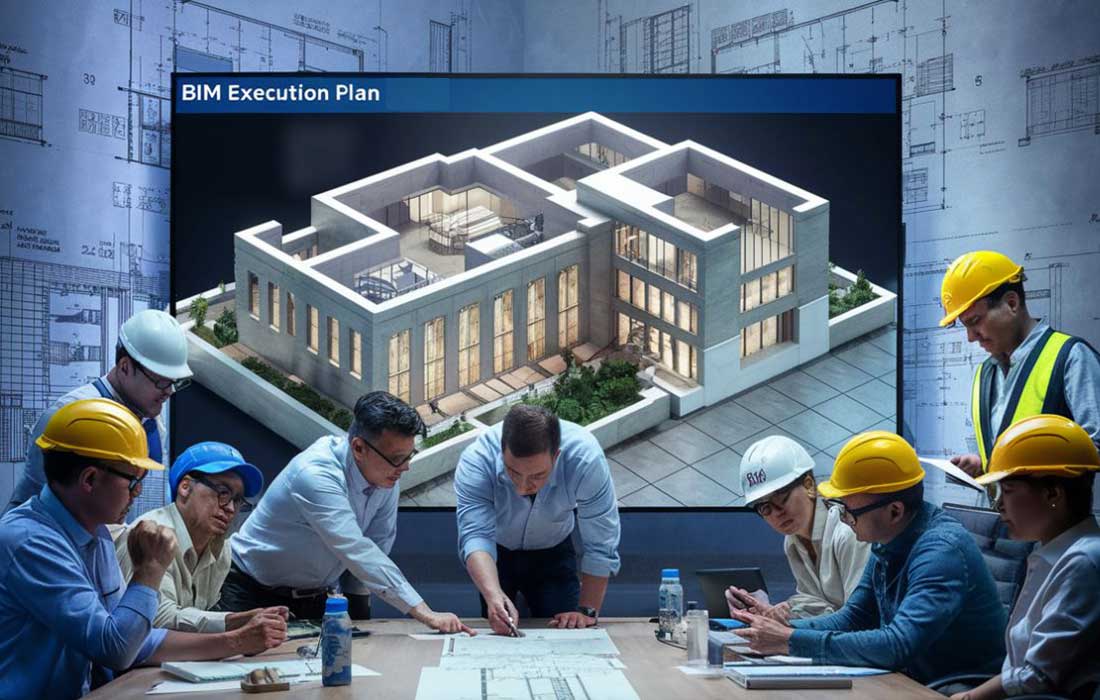Essential Guide to what is BIM Execution Plans (BEP) for Effective Project Execution
In the field of modern construction, the adoption of Building Information Modeling (BIM) has revolutionized project execution. A well-crafted BIM Execution Plan (BEP) acts as a roadmap, guiding project teams through various phases of the project. This essential guide explores the details BIM execution plans and their significance in effective project management.

Introduction to What is BIM Execution Plan
Let’s Understand What is BIM Execution Plan?
A BIM Execution Plan (BEP) is a strategic document that outlines the processes, roles, and responsibilities necessary for the successful implementation of BIM within a construction project. It serves as a comprehensive framework detailing how various teams will use BIM throughout the project lifecycle, focusing on project information management and BIM deliverables. By defining the BIM processes, a BEP ensures that all stakeholders are aligned and informed about the expectations and goals associated with the BIM project.
Importance of a BIM Execution Plan in Project Execution
The importance of a BIM Execution Plan in project execution cannot be overstated. It facilitates the planning process by providing clarity on project scope, timelines, and deliverables. A well-structured BEP enhances communication among the project team, minimizes misunderstandings, and fosters collaboration. Moreover, it allows for effective monitoring and management of the BIM implementation plan, ensuring that the project adheres to the national BIM standard and achieves its intended outcomes.
Overview of Building Information Modeling (BIM)
Building Information Modeling (BIM) is a digital representation of the physical and functional characteristics of a facility. It encompasses various uses on the project, including design visualization, clash detection, and lifecycle management. The overview of BIM emphasizes its role in improving project efficiency, reducing costs, and enhancing decision-making. By leveraging the detailed BIM use and its applications, project teams can achieve better coordination and reduce risks associated with traditional construction methods.
Components of a BIM Execution Plan (BEP)
Key Elements Included in a BIM Execution Plan
A comprehensive BIM Execution Plan includes several key elements that are critical for successful BIM project execution. These elements typically encompass the project goals, stakeholder engagement strategies, and a clear outline of BIM deliverables. By detailing the management plan and relevant workflows, the BEP ensures that all parties understand their roles and contributions to the BIM process, ultimately enhancing efficiency and effectiveness in project delivery.
Defining the BIM Project Scope
Defining the BIM project scope is a crucial component of the BIM Execution Plan. This involves establishing the objectives, constraints, and deliverables required for the project. By clearly defining the BIM scope, project teams can effectively allocate resources, manage expectations, and ensure that all stakeholders are aligned with the project goals as detailed in the overview of the BIM. A well-defined scope also enables effective tracking of progress and facilitates adjustments as necessary throughout the BIM implementation process.
Project Team Roles and Responsibilities
Establishing clear roles and responsibilities within the project team is vital for the successful execution of a BIM project. Each team member must understand their specific contributions to the BIM execution plan, ensuring accountability and fostering collaboration. The delineation of roles assists in streamlining communication and coordination, ultimately enhancing the overall effectiveness of the BIM project execution planning guide. By ensuring everyone is aware of their responsibilities, the potential for miscommunication and project delays is significantly reduced.
Developing a BIM Project Execution Plan
Steps to Create a BIM Project Execution Planning Guide
Creating a BIM Project Execution Planning Guide involves several critical steps that ensure the project aligns with the overall BIM execution plan and the master information delivery plan. Initially, project teams must define the project scope and identify key stakeholders. Following this, they should outline the necessary BIM processes and deliverables, ensuring clarity on responsibilities. Establishing a management plan to monitor progress and compliance with the national BIM standard is essential. Finally, continuous communication and collaboration among stakeholders will help refine the BIM plan as the project evolves.
Designing the BIM for Your Project
Designing the BIM for your project involves integrating various BIM uses to suit the project’s specific needs. This encompasses creating a detailed BIM model that reflects the physical and functional characteristics of the construction project. Effective design requires collaboration among the project team to incorporate feedback and implement best practices. Utilizing advanced tools for design visualization and clash detection is crucial, as these help mitigate risks and enhance the overall effectiveness of the project, which is included in a BIM execution plan template. By focusing on the detailed BIM use, teams can optimize workflows and achieve better project outcomes.
Developing the BIM Implementation Plan
Developing the BIM Implementation Plan is essential for the smooth adoption of BIM practices within a construction project. This plan should clearly outline the scheduled activities, tools, and technologies that will be employed to facilitate the BIM process. Additionally, it should define the roles of team members, ensuring everyone understands their responsibilities in the BIM execution plan. Regular assessments and adjustments to the implementation plan are vital, as they help maintain alignment with the defined project goals and adapt to any challenges encountered during the project lifecycle.
Implementing BIM in Projects
BIM Implementation Strategies
Effective BIM implementation strategies are crucial for realizing the benefits of Building Information Modeling in construction projects. These strategies should encompass training for the project team, ensuring they are proficient in BIM tools and processes. Additionally, establishing clear communication channels and collaboration platforms can significantly enhance teamwork. It is also important to align the BIM project execution planning guide with the overall project execution strategy, thereby maximizing efficiency and minimizing conflicts through the development of the BIM plan. Incorporating BIM use cases and best practices will further enhance the implementation strategy, ensuring successful project delivery.
Infrastructure for BIM Implementation
The infrastructure for BIM implementation plays a vital role in supporting the various phases of the project, aligning with the master information delivery plan. This includes ensuring adequate software, hardware, and network capabilities to facilitate smooth BIM operations. A robust data management system is essential for managing project information effectively, allowing for real-time updates and collaboration among the project team as outlined in the BEP guide. Furthermore, establishing a centralized BIM repository can streamline access to BIM deliverables and documentation, enhancing overall project efficiency. Investing in the right infrastructure is fundamental to the successful implementation of BIM processes within the project.
Benefits of Having a BIM Execution Plan
The benefits of having a BIM Execution Plan are manifold, significantly impacting project execution and outcomes. A well-defined BEP fosters better communication among stakeholders, leading to improved collaboration and reduced misunderstandings. It also enhances project visibility, allowing for more effective tracking of progress and deliverables in accordance with the BIM execution plan template. Additionally, the implementation of a BIM execution plan can lead to cost savings by identifying potential issues early and minimizing rework. Ultimately, a comprehensive BIM execution plan is instrumental in achieving project objectives and delivering high-quality results within the specified timeline and budget.
National Standards and Guidelines
Overview of the National BIM Standard
The National BIM Standard serves as a foundational framework that guides the implementation of Building Information Modeling across various construction projects, forming the basis of the BIM project execution planning procedure. It outlines best practices, protocols, and performance metrics designed to ensure consistency and quality in BIM execution. Adhering to these standards enables project teams to effectively manage project information and ensures that all BIM deliverables meet the necessary requirements for compliance and interoperability. By following the National BIM Standard, stakeholders can enhance collaboration and streamline the BIM processes, ultimately leading to improved project outcomes.
Importance of Compliance with BIM Standards
Compliance with BIM standards is critical for the successful execution of any construction project that incorporates Building Information Modeling. Following established guidelines ensures that all members of the project team understand their roles and responsibilities within the BIM execution plan. Moreover, adhering to these standards minimizes risks associated with project information management and facilitates better communication and coordination among stakeholders. It also enhances the credibility of the BIM project, as compliance reflects a commitment to quality and professionalism, which can be essential for securing future contracts and partnerships.
Resources for BIM Project Teams
Numerous resources are available to assist BIM project teams in effectively implementing the BIM execution plan and adhering to national standards. These resources include templates for creating a BIM execution plan, access to training programs on BIM software and methodologies, and online communities where professionals can share best practices and insights. Additionally, industry publications and guidelines provide valuable information on the latest trends and innovations in BIM. By leveraging these resources, project teams can enhance their understanding and application of BIM processes, ensuring more successful project execution and delivery.
Conclusion
Recap of the Importance of BIM Execution Plans
In summary, BIM execution plans are essential documents that play a pivotal role in the successful execution of construction projects using Building Information Modeling. They provide a structured approach to defining project scope, roles, and responsibilities, ensuring all stakeholders are aligned and informed. By integrating a well-crafted BIM execution plan into the project lifecycle, teams can enhance collaboration, streamline communication, and ultimately achieve their project goals more efficiently.
Future Trends in BIM and Project Execution
The future of BIM and project execution is poised for significant advancements, driven by technological innovations and evolving industry practices, particularly in the context of the BIM execution plan template which uses software like Autodesk Revit. Trends such as increased automation, the integration of artificial intelligence, and the use of virtual reality are expected to reshape how BIM uses on the project are implemented. Additionally, the emphasis on sustainability and energy-efficient designs will play a crucial role in the development of future BIM processes. As these trends emerge, project teams must remain adaptable and proactive in refining their BIM implementation plans to leverage these advancements effectively.
Final Thoughts on Effective BIM Project Execution
Effective BIM project execution hinges on a thorough understanding of the BIM execution plan and its components. Emphasizing the importance of collaboration, communication, and compliance with national standards can lead to enhanced project outcomes and a successful BIM project execution planning procedure. By continually assessing and refining the BIM implementation plan, project teams can not only achieve their immediate goals but also position themselves for long-term success in an ever-evolving construction landscape. Ultimately, a commitment to effective BIM practices will be key to driving innovation and delivering high-quality results in future construction projects.
Other related Articles : Benefits of BIM for Architects
Other related Articles : BIM For Facility Management
Frequently Asked Questions (FAQs)
What is a BIM Execution Plan (BEP)?
A BIM Execution Plan (BEP) is a comprehensive document that outlines the use of BIM (Building Information Modeling) on a project. It details the procedures, processes, and strategies for implementing BIM throughout the project lifecycle, ensuring all project participants are aligned and can effectively collaborate.
Why is a BIM Execution Plan important for project execution?
A BIM Execution Plan is crucial for effective project execution as it helps in coordinating efforts, defining roles and responsibilities, and setting clear guidelines for the use of BIM. This ensures that all team members are on the same page, which can lead to improved efficiency, reduced errors, and better project outcomes.
What should be included in a BEP?
A BEP should include several key elements such as the project goals, BIM uses for the project, roles and responsibilities, information exchange protocols, modeling standards, quality management plan, and the procedures for implementing each BIM use. It should also outline the steps of the planning and execution process.
How do you develop a BIM Execution Plan?
To develop a BIM Execution Plan, project participants should be clearly identified, and their roles and responsibilities defined. The team should collaborate to outline the project goals, specific BIM uses, and the procedures for implementing BIM on the project. It is also essential to establish information exchange protocols and modeling standards.
Who is responsible for developing the BIM plan?
Typically, the project manager or BIM manager is responsible for developing the BIM plan. However, it is a collaborative effort that involves input from various project participants, including architects, engineers, contractors, and owners. The team should work together to ensure the plan is comprehensive and aligns with the project goals.
What are the steps involved in the BIM project execution planning procedure?
The BIM project execution planning procedure involves several steps: defining the project goals, identifying specific BIM uses, developing the BIM plan, establishing information exchange protocols, setting modeling standards, and implementing the plan. Each step is crucial for ensuring the successful use of BIM on the project.
How is the quality management plan related to the BEP?
The quality management plan is an integral part of the BEP. It outlines the procedures and standards for ensuring the quality and accuracy of the BIM models and data. This includes regular reviews, audits, and validation processes to ensure that the BIM execution process meets the project and company standards.
At what stage of a project should the BEP be developed?
The BEP should be developed during the early stages of a project. This allows for proper planning and coordination among all project participants from the outset, ensuring that the use of BIM is effectively integrated into the project workflow.
How does the BEP help in implementing BIM on the project?
The BEP provides a detailed roadmap for implementing BIM on the project. It outlines the specific BIM uses, procedures, and standards that need to be followed. By having a clear plan, project participants are able to design an execution process that aligns with the project goals, leading to more efficient and effective use of BIM.
What are some common BIM uses for a project that should be included in a BEP?
Common BIM uses for a project that should be included in a BEP include design authoring, design review, coordination, quantity takeoff, phase planning, and construction scheduling. Each of these uses should be clearly defined in the BEP, along with the procedures for implementing them.



